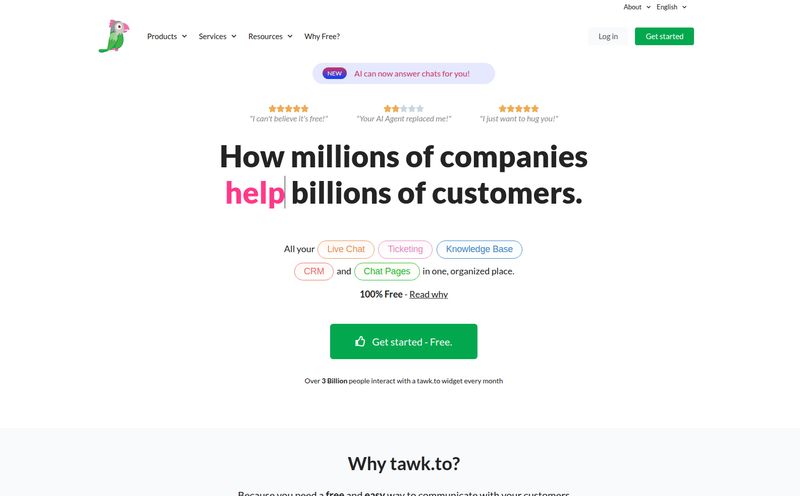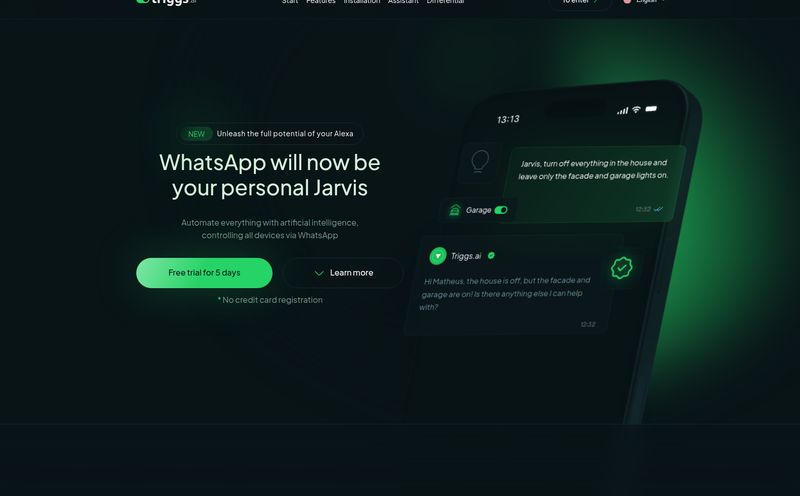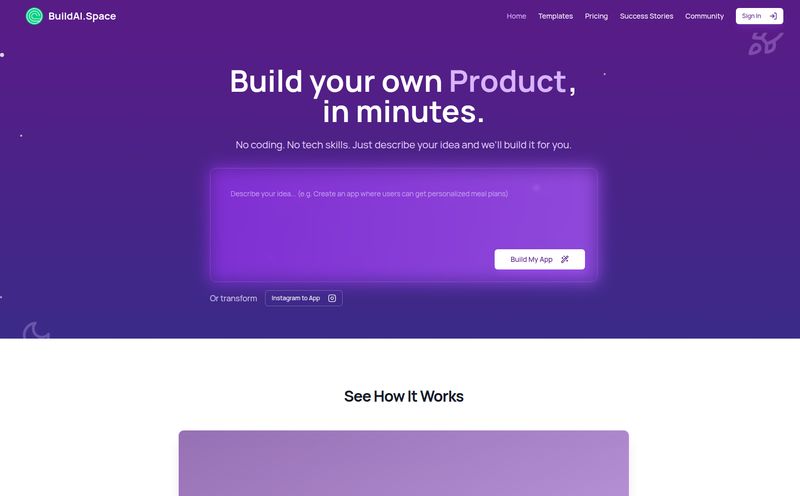I’ve been in the SEO and web dev game for a while now. Long enough to remember when 'responsive design' was a revolutionary concept and not just, you know, the standard. And in all that time, I've seen countless tools promise to change everything. Most of them fizzle out. They’re either too clunky, too limited, or solve a problem nobody actually has.
So when I first heard about Chat2Code, my inner cynic just shrugged. "Another AI code generator," I muttered to my lukewarm coffee. "Great." But then I saw it in action. And I have to admit, my cynical old heart skipped a beat. This one... this one feels a little different. It's not about replacing developers; it feels more like giving them a seriously smart apprentice.
So, What Exactly Is Chat2Code?
Let's get the jargon out of the way first. Chat2Code is an AI-powered platform for generating and messing with React components interactively. In plain English? You tell it what you want in simple text, and it builds it for you. Right there. In your browser. Instantly.
Think about that for a second. No more creating a new file, typing out `import React from 'react'`, setting up the basic function, and then starting to code. You just... ask. It feels less like coding and more like having a conversation with your UI. It's built on top of OpenAI models (like GPT-3 and others), which gives it some serious horsepower for understanding what you mean, even if your prompt isn't perfectly phrased.

Visit Chat2Code
Getting My Hands Dirty: The First Five Minutes
The homepage is clean. Almost deceptively simple. You're greeted with a big prompt box and a few toggles: OpenAI Model, Framework (locked to React for now), TypeScript, and AutoDeps (for automatically handling dependencies).
My first test was, of course, the classic. The developer's "hello world": a login page.
I typed: "generate a login page with email and password fields, and a submit button"
I hit send. And boom. There it was. A fully functional, albeit basic, login form rendered on the right side of the screen. The code was on the left. No fuss, no waiting. It was... impressive.
What I found really neat was the "Latest public generations" feed on the main page. It’s a running list of what other people are building. I saw prompts in English, French, and Spanish for things ranging from simple buttons to more complex stuff like an image palette generator. It's a great way to get ideas and see the tool's potential before you even type a single word.
The Standout Features That Actually Matter
A lot of tools are feature-packed but practically useless. Chat2Code seems to focus on a few things and do them exceptionally well.
It's a Conversation with Your Code
This is the magic right here. After generating my login form, I didn't have to start over to change it. I just continued the conversation. I typed, "now add a 'forgot password?' link below the button." A few seconds later, teh link appeared. Then, "make the submit button blue and the text white." Done. This real-time feedback loop is incredibly powerful for rapid prototyping. It's like having a high-speed digital sous-chef for your front-end kitchen—you call out the ingredients and the prep work, and it just gets done.
Simplicity That Doesn't Feel Stupid
I can see this being a game-changer for people just starting their coding journey. The fear of the blank page is real. Chat2Code completely removes that. It provides a solid, working foundation that you can then tweak and learn from. But it's not just for beginners. As an experienced dev, I see its value in blowing through the boring, repetitive parts of my job. Why should I spend 15 minutes scaffolding a basic card component for the tenth time this week when an AI can do it in 15 seconds? My time is better spent on logic, state management, and all the tricky stuff.
All In on React
Right now, Chat2Code is a one-trick pony: it does React. Some might see this as a huge limitation. If you're an Angular or Vue developer, this tool isn't for you. But frankly, I think it's a smart move. By focusing solely on the React ecosystem (including options for TypeScript), they can fine-tune the AI's output to be more accurate and idiomatic. It's better to be a master of one trade than a jack of all, especially in the early days.
Where It Shines and Where It Stumbles
No tool is perfect. Let's be real. While Chat2Code got me excited, it has its rough edges.
The good stuff is obvious: speed, visual feedback, and a lower barrier to entry. It’s fantastic for whipping up quick prototypes, building out standard UI elements, or just experimenting with component ideas without the overhead of a full local dev environment.
However, you need to keep your expectations in check. This isn't going to build a complex, enterprise-level application for you with a single prompt. The AI is good, but it's not a mind-reader. For highly customized, unique components with complex business logic, you're still going to need a human brain and human hands on the keyboard. I've also found that you still need to read the code it generates. Don't just blindly copy and paste. Use it as a starting point, a very advanced one, but review it to make sure it meets your standards for quality and security.
So, What's the Price Tag?
Here's the interesting part. As of my writing this, I couldn't find any pricing information. The website doesn't have a pricing page, and there's no mention of plans or tiers. This usually means one of two things: it's either in a public beta phase and completely free for now, or it will operate on a freemium model in the future. My guess is the former. They're likely gathering data and refining the product before they think about monetizing. So for now, it seems you can go nuts and generate to your heart's content without pulling out your credit card.
Who Is This Tool Actually For?
- The Junior Developer: An incredible learning tool to see how prompts translate into real, working React code.
- The Prototyper / UI/UX Designer: A way to create interactive mockups that are more than just static images.
- The Backend Dev: For the full-stack or backend engineer who just needs a decent-looking front-end for their API without spending a week on CSS.
- The Seasoned Front-End Pro: A massive time-saver for boilerplate code. Lets you focus your expensive brainpower on the hard problems, not on building another modal.
Frequently Asked Questions
First off, what is Chat2Code again?
It's an interactive web tool that uses AI to generate React components from plain text prompts. You can ask it to build something, then ask for changes, and see it all update in real-time.
What frameworks does Chat2Code support?
As of now, it's exclusively focused on React. You can also toggle TypeScript on or off for your generated components.
Is Chat2Code free to use?
Currently, yes. There is no pricing information available on their site, which suggests it's in a free beta period. This could change in the future, of course.
Can I build a complete, complex application with it?
Not really. Its strength is in generating individual components. While you could piece these components together to build an app, it's not designed to handle things like routing, global state management, or complex application architecture. Think of it as a component factory, not an entire car assembly line.
How accurate is the AI-generated code?
For standard components, it's surprisingly good. However, the more complex or niche your request, the higher the chance of weirdness. It's critical to treat the output as a first draft and review it carefully before using it in a production environment.
Can I share the components I create?
Yes! The platform has a feature to share your generations. This is great for collaborating with colleagues or just showing off something cool you made.
My Final Verdict: A Glimpse into the Future?
I came in a skeptic and I'm leaving a... cautious optimist. Chat2Code isn't going to take our jobs. Not yet, anyway. What it will do is change them. It's a tool that automates the tedious, the boring, the repetitive. It frees up our mental bandwidth to focus on creativity and complex problem-solving—the stuff that humans are still way better at.
It's a step towards a future where development is more about architectural decisions and user experience, and less about the syntax of a for-loop. It's not perfect, but it's one of the most promising and genuinely useful AI coding tools I've seen in a long time. Give it a try. The worst that can happen is you save yourself a few hours of work.



